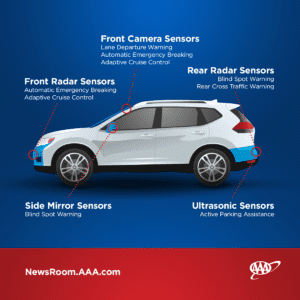BOISE – October is Car Care Month, a timely reminder for drivers to make sure their vehicles are ready for the cold days ahead. But if you’re having a new car repaired or even completing routine maintenance, you could be in for some sticker shock. AAA says that most new vehicles are equipped with at least one advanced driver assistance system (ADAS) supported by delicate cameras and sensors that can be expensive to re-calibrate and replace.
That’s a concern, because according to AAA’s previous research, 1 in 3 Americans said that they wouldn’t be able to afford an unexpected repair bill without going into debt.
“About 70 percent of the vehicles that rolled off the assembly line this year have at least one ADAS feature as standard equipment, and nearly 96 percent of vehicles have at least one as an available option,” says Matthew Conde, public affairs director for AAA Idaho. “When ADAS sensors and cameras are initially aimed by the manufacturer, they relay data that could help avoid a collision. But if they’re out of alignment, they may not work as intended, with dangerous consequences.”
As long as the technicians at the shop making the repairs have the necessary tools and training, they can complete an ADAS repair job in addition to the other work being performed. But even minor repairs like wheel alignment could require ADAS re-calibration, and customers should always ask for proof that this step has been completed before the repairs are finished.
AAA estimates that ADAS repair can add $3,000 in repair costs on top of other repairs or body work. Cameras and sensors are built into windshields, bumpers, and side view mirrors that can be easily damaged in a collision.

“As an example, windshields are one of the most common vehicle repairs, with 14.5 million of them replaced each year. ADAS-incorporated windshields can cost up to three times more,” Conde said. “These cameras and sensors allow the vehicle to ‘see’ the world around them, so it’s a good idea to make sure that their vision isn’t cloudy.”
2 out of 3 U.S. drivers say they do not trust repair shops to charge fairly or complete the work correctly.
AAA’s Car Care Tips
“Repair shops have suffered some unfair criticism because of the poor business practices of a few,” Conde said. “Fortunately, there are many ways to build a good relationship with a repair facility.”
AAA rescued more than 14,000 Idaho drivers last fall and expects to help almost that many this year. Tows, dead batteries, lockouts, and flat tires are the biggest culprits.
To keep your car in peak performance:
- Budget for vehicle repairs. Set aside a little money each month to cover routine maintenance and unexpected repairs. Review your owner’s manual to identify expensive items that could need repair or replacement, including ADAS features. The less debt you have to take on to fix your car, the better.
- Do your homework. AAA’s Approved Auto Repair Shop Locator features over 7,000 facilities that meet AAA standards for customer satisfaction and technical expertise. Choose one of them by visiting com/aar or ask friends and neighbors about repair shops they’ve visited. Go online to research the shop’s certifications and capabilities.
- Test the water. Try out the shop you’ve selected with some low-cost, routine maintenance, like an oil change or tire alignment. As you get more comfortable, you can have the shop complete bigger jobs.
- Ask about ADAS. Ask the technician to confirm that cameras and sensors have been properly re-calibrated to manufacturer specifications as needed.
- Make a safe BET – Remember the acronym B-E-T, and have your battery, engine, and tires inspected this fall. If your battery is three years old or older, it should be checked, along with your electrical system. Resolve engine leaks right away, and consider replacing your tires when they have 3/32” of tread or less. Use the quarter test to see how your tires are doing – turn a quarter upside down in the tread, and if you can see the top of George Washington’s head, it’s time to think about changing the tire.

